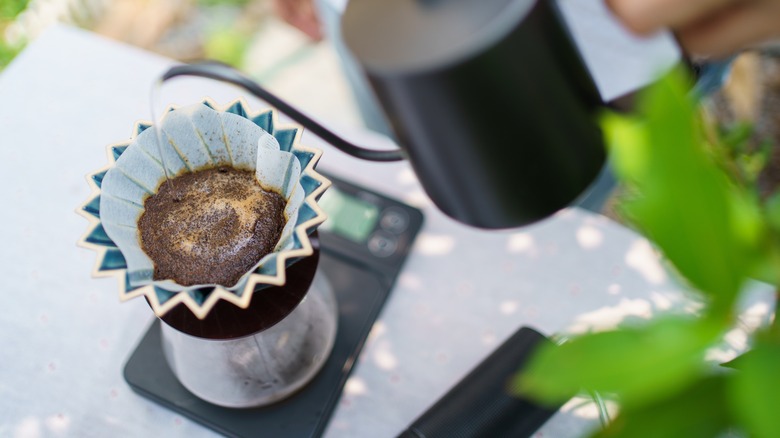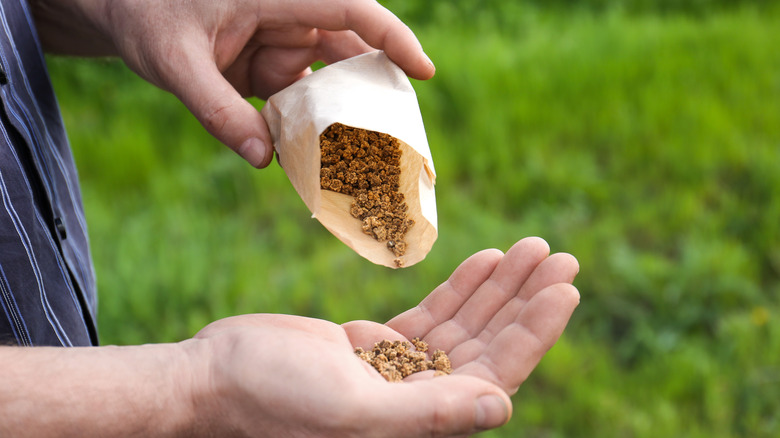Prep For Gardening Season With This Seed-Saving Coffee Filter Trick
Coffee filters are one of the most versatile items you can keep on hand. Not only are they instrumental in giving you that morning pick-me-up, there are dozens of other creative uses for coffee filters around the house, including shining, polishing, dusting, and even cooking. Part of the attraction of coffee filters is that they come in a variety of sizes and are lightweight, inexpensive, and easy to store. They're also porous which helps promote a dry environment that won't encourage bacteria or mold growth. Many are also chemical- and chlorine-free. All of these qualities make them ideal to use as seed storage envelopes to prepare for the next gardening season.
It's already a well-known gardening hack to start, or germinate, seeds in coffee filters or paper towels at planting time. Coffee filters make seed starting incredibly easy because, when moist, they provide just the right combination of conditions for growth. But now, you can also use dry coffee filters at the end of the growing season after you've harvested your crops. Coffee filters tend to work better than paper towels because they're more porous, so the seeds won't stick to the material. With some very simple instructions, they make an ideal tool for collecting and storing seeds between planting seasons.
Make coffee filters into seed envelopes
According to YouTuber Joy Home Remedies, to make your coffee filters into seed envelopes, all you need are coffee filters, scotch tape, and small snack-size plastic baggies or glass jars. First, make sure your seeds are thoroughly rinsed and dried. Then, carefully inspect them for any signs of rot, early germination, or bug infestation. If you see any seeds with these issues, you'll need to throw them away. Also look for uniformity in your seeds so you're not saving cross-pollinated seeds by mistake.
Next, place a couple dozen of the seeds on a flattened coffee filter and label the filter with the seed variety and date of harvest. This will help you keep your seed collection organized and take any of the guesswork out when you're ready to plant next year. If your seeds were not already thoroughly dried, leave them on the filter for a couple days to make sure there is no moisture left.
Finally, fold the filter over a few times to make sure the seeds are snugly positioned inside. Then, secure the packet with a strip of tape. You may store them this way or place the seed packet in a small plastic baggy or lidded glass jar. It's a good idea to label the outside of the baggy or jar with the contents to make it easy to organize your collection.
Seed storage tips
Properly stored seeds should keep for anywhere between one and 10 years, especially if they were completely dried before storage. The recommendation is to dry seeds outdoors in the shade or in a very low oven of no more than 100 degrees with the door open. Avoid microwaving them because too much heat can affect germination.
The optimal location for storing your seeds comes with a few guidelines as well. Ideal storage conditions are dry and cool, so refrigerating them is your best bet. Basements and interior spaces such as cupboards or pantries in climate-controlled homes are also fine spaces for seed storage. If you're at all concerned about moisture, you can add a silica gel desiccant to your seed envelopes or jars before you store them. These can be purchased at most major home goods stores or from online retailers.
Coffee filters are just one of many clever ways to store the seeds you collect from your garden. No matter how you choose to do it, saving seeds is a healthy investment in the future. While you're at it, feel free to enjoy a freshly brewed cup of coffee.

